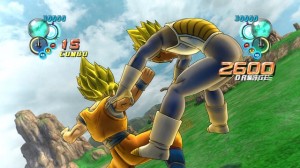Dragon Ball Z Ultimate Tenkaichi Review (360)
- Updated: 23rd Nov, 2011
 There are many games that appeal to the masses. Love football? Then most likely you will seek out FIFA 12 or PES 2012. Love ‘pwning’ people, shooting them, and smack-talking? Well Modern Warfare 3 is now out there for you too. Then there is Dragon Ball Z Ultimate Tenkaichi, the latest in the Tenkaichi Budokai (translation: ‘Strongest under the Heavens’) series of games that began way back on PS2. These, of course, tie in with the hugely popular Dragon Ball Z (DBZ) anime shows, which actually finished in Japan in 1997 and the US/UK in 2005. Each Saga (i.e. series) had the pulling power of new characters but now that the show has long since finished, why should anyone care about this title?
There are many games that appeal to the masses. Love football? Then most likely you will seek out FIFA 12 or PES 2012. Love ‘pwning’ people, shooting them, and smack-talking? Well Modern Warfare 3 is now out there for you too. Then there is Dragon Ball Z Ultimate Tenkaichi, the latest in the Tenkaichi Budokai (translation: ‘Strongest under the Heavens’) series of games that began way back on PS2. These, of course, tie in with the hugely popular Dragon Ball Z (DBZ) anime shows, which actually finished in Japan in 1997 and the US/UK in 2005. Each Saga (i.e. series) had the pulling power of new characters but now that the show has long since finished, why should anyone care about this title?
The series adopted the ‘Tenkaichi’ subtitle after the release of Budokai 3, which was more of a bog-standard one-on-one 2D fighter. The dynamic was shifted somewhat in the Tenakaichi games to render the fights even more faithful to the TV show. It was initially a very confusing move. The view was almost third-person, hardly ideal for a one-on-one fighter. However, this has developed over time into an amalgamation of the 2D style, with the normal left and right view when opponents are close (Melee Range), and the third person view when opponents are far apart (Blast Range). If you’re too far away, a quick double tap of ‘A’, and your character will boost forward to the opponent, with the chance to strike a blow also. The graphics are cel-shaded, suiting the look and feel of the series perfectly. The voice actors are from the original series too.
Unfortunately, this is about as original as the game gets. The fighting system, combo system and aforementioned boost attacks are far too simple to be engaging in any way. There is only one melee attack button and after a few taps you’ll get a QTE with the maximum of two choices, X or Y. Then it’s a (very) simple case of holding a direction and pressing the right button with no skill or timing required. Yawn. The same goes for Blast Range; fire off a series of Ki blasts with X, and the same QTE clash happens. Again, yawn. You can counter these ‘Attack Clashes’ by pressing the same button as your opponent, but this is pure luck, not skill, and is ultimately tiresome.
Each character is assigned two signature moves and even these are performed in an incredibly simple manner; by flicking the right stick up or down. The spirit gauge that fuels these moves is easily filled by using the boring techniques described above, over and over again. The only addition to this system is an ultimate finisher which unlocks as the fight goes on towards its conclusion. However, as exciting as that sounds, execution of such a move is just a click of the right stick away. Zzzzzzzz…
There is some hope provided, as with many DBZ releases over the years, with the Story Mode. As a fan of DBZ myself, this is what I look forward to the most in a DBZ game – to be the characters in the story and fight in the battles that took place in the series. The cutscenes look new, with the faithful drawings from author Akira Toriyama brought to life on screen once again. There are certainly hours to be lost in this mode alone and some nice touches. Flying around the map area allows you to continue with the main story, have practice fights, or even find the seven Dragon Balls, which are cleverly used to unlock bonus material for other modes.
 However, even for a fan such as me, it’s all over the place. The story-telling is patchy at best. There are massive gaps in the story – mostly the best bits – and these are told by a window of slow, white text on a black background. Very droll indeed. This also leads to the dialogue looking even more random and to a non-fan it would be utterly pointless. Dragon Ball Z can be a confusing anime at the best of times. This won’t help draw in new fans.
However, even for a fan such as me, it’s all over the place. The story-telling is patchy at best. There are massive gaps in the story – mostly the best bits – and these are told by a window of slow, white text on a black background. Very droll indeed. This also leads to the dialogue looking even more random and to a non-fan it would be utterly pointless. Dragon Ball Z can be a confusing anime at the best of times. This won’t help draw in new fans.
There is also Hero Mode, which allows the player to create their own warrior, albeit in a limited manner, and play out a new story in a parallel universe to DBZ itself. Be prepared to work for it though. Any warrior created needs to build up power and abilities that are unlocked as you succeed in battles throughout the map. It’s something different but is ultimately just a spin on Story Mode. More of the same, unfortunately.
Overall, this game was certainly only designed with the Dragon Ball Z fan in mind but, unfortunately, I had nowhere near as much fun with this as I did with the original Budokai series. It’s difficult to market this for kids also, as Cartoon Network did with the TV series by heavily editing it for their target audience. Ultimately, everyone is just kicking the crap out of each other, there is bad language, and the game overall has a very serious tone. It’s rated PEGI 12, which I find misleading as the games retain the violence and bad language. It may be cartoony, but violence is violence at the end of the day. I certainly wouldn’t be comfortable with my 10 year old playing it. Although, to be fair, even he said it looked rubbish.
Despite that, I still find myself getting excited knowing which bad guys are coming up later in Story Mode. There is no skill involved in the fights and every attack scenario is 50/50 but I just love that Kamehameha attack and the long, Super Saiyan glowing yellow hair. Long crazy/mental/shouty/musclar/macho-voice-acting story short, it’s terrible. I do love it but this game is only for die-hard fans of the franchise.
Dragon Ball Z: Ultimate Tenkaichi is available now on Xbox 360 and PlayStation 3


Follow Us!